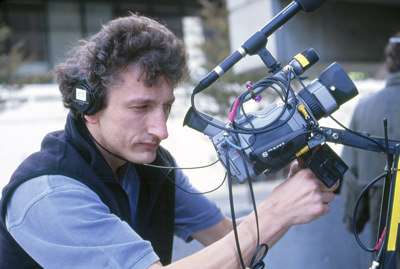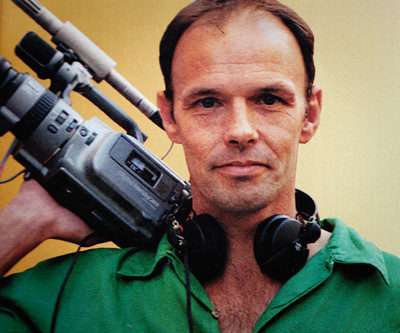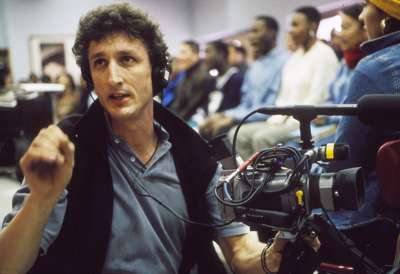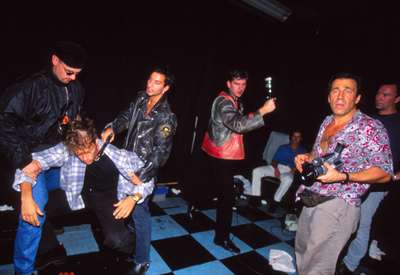Video's Gutenberg Moment
How the VX1000 camera revolutionized news, documentaries, and porn.

In 1995, a decade before the launch of YouTube, Sony released an unassuming digital video camera called the VX1000 with little fanfare. It cost $3,500—or about 1/30th the price of the standard camera used by television crews. At the time, executive producers and studio executives were the gatekeepers of the screen, thanks in part to the astoundingly expensive and technically cumbersome camera rigs and editing systems required to produce moving pictures. The idea that a single person could earn a living shooting video with a camera that cost less than a used car was absurd.
Today, it's unusual to encounter someone in the U.S. who isn't carrying a high-definition video camera at all times. Human beings upload 100 hours of video to YouTube every minute, which their audiences consume at a rate of 6 billion hours per month, or about one hour per person on Earth. But YouTube would be a stale library of corporate videos and old game show episodes if it weren't for inexpensive and easy-to-use gear that enables anyone with a few thousand dollars to match the technical prowess of broadcast production shops.
The VX1000 and its descendants set the stage for the online video revolution, supercharging the independent film movement, freeing creatives from their financiers' dictates, and empowering directors and producers to devise brand new ways of telling stories via moving images.
The tale of how this remarkable machine turned the film and TV industries upside down provides clues about what to expect from the audiovisual medium in the near future, when virtually every person on the planet may be carrying a recording device 100 times as powerful as the best video cameras in existence today.
Documentaries Get Intimate
"I lay awake for three nights thinking, 'The world has changed,'" recalls engineer and filmmaker Adam Wilt, referring to the first time he handled a VX1000 at a Fry's Home Electronics store in October 1995. At that point, most TV producers and film directors either shot their work on film, which was expensive and slow to process, or they used Beta SP, a higher-quality version of the failed consumer tape format BetaMax.
Beta SP camcorders were large and heavy, required constant maintenance, and cost about as much as a modest home—a complete camera package ran at around $100,000. Wilt, who at the time conducted a detailed side-by-side comparison of a VX1000 to a Beta SP camcorder, was shocked to discover that the two machines yielded images that were almost the same quality.
What's more, the camera was easy to use. It recorded footage on inexpensive digital cassettes that ran for an hour and could be offloaded to a computer by attaching a single cable. The VX1000 had excellent battery life, and it was light and compact—users could operate it with one hand or slip it in a shoulder bag. For the first time, a tourist could capture professional quality video, and a professional cameraman could be easily mistaken for a tourist.
For Chris Terrill, a British filmmaker who was working at the BBC when he discovered the VX1000 in 1995, the camera's modest appearance was its best attribute. Terrill had a background in radio and was used to working "alone and fast," so he was constantly frustrated by the presence of large film crews on all of his stories. In part so he'd stop complaining, Terrill's bosses gave the go-ahead to an experimental project: He would take a VX1000 and spend a year alone making a documentary about life in Soho, a posh neighborhood in London. "The VX1000 became everything to me and it became the way I saw the world," says Terrill.

Terrill's project became Soho Stories (1996), a 12-part series that drew a large audience and won a prestigious Royal Television Society Award. Terrill adopted a style known as observational filmmaking, in which the camera and director get out of the way and capture real situations as they unfold.
This approach was pioneered decades earlier by documentarians Frederick Wiseman and Albert and David Maysles, along with experimental filmmakers like Frank Gillette, who in the summer of 1968 captured five hours of every day life on a street in New York City. Gillette and a small community of filmmakers had embraced a low-resolution consumer device called the Portapac, which hit the market in 1967 and was comprised of a box camera attached to a separate tape recorder that hung from a shoulder strap. It was clunky and cumbersome by today's standards, but determined filmmakers relished the freedom it gave them to venture out into the world for the first time and make movies.
The VX1000 made observational filmmaking much easier to pull off: It combined the camera and recorder into one compact device that required very little attention from its operator, who could nimbly maneuver around a scene.
Terrill's series captures moments that at the time were rarely seen in documentaries. He filmed London cops responding to emergency calls, and he ventured into tiny dressing rooms at burlesque clubs, interviewing strippers and prostitutes. Terrill's lone-wolf approach meant there was no crew to disrupt the action. In one particularly emotional scene, which Terrill describes as "TV gold dust," a transvestite named Danny shared his feelings about his sexuality while the VX1000 quietly rolled.
After completing Soho Stories, Terrill recalls being summoned to his bosses' office. When he arrived, they looked agitated. "You're too far under budget," one executive told him. He fretted that on the "sixth floor," where the network's top brass resided, "they'll start expecting every project to cost so little."
TV News Gets Leaner
Producer Jeff Folmsbee had a similar confrontation in 1995, when he was preparing to launch City Arts, which later became the first regularly scheduled program shot entirely with the VX1000. Folmsbee was developing his show for Channel Thirteen, the flagship PBS station in New York City. The station's board of directors, which at the time included the legendary CBS newsman Walter Cronkite, asked him to make a presentation about his new show.
Folmsbee explained to the board how these easy-to-use digital cameras made it so his producers could serve as their own cameramen, like a reporter with "a pad and pencil." The legendary CBS anchor spoke up. "That's exactly what you should not be doing," Cronkite barked. "This is the problem with where television is going today—you're trying to have one person do the job of three people."
It would have been impolitic in that moment for Folmsbee to point out that his pad-and-pencil-wielding videographers also captured pictures superior to those produced by traditional TV cameramen. Station shooters tended to be burly men with the strength to cart around giant bags of equipment and balance 16-pound cameras on their shoulders for extended periods. Cameramen had to possess considerable knowledge of how to patch cables and solve technical glitches in the field.

But when it came to visuals, TV cameramen specialized in what industry folks call "wallpaper"—shots that fill the screen but don't enhance the story. Even 60 Minutes, the pride of Cronkite's old news division, was "radio with pictures," as the show's creator and Executive Producer Don Hewitt characterized it. In other words, the show's visuals were an afterthought. Layered under the program's carefully constructed narrations, viewers vegetated on banal shots of subjects pecking at word processors or awkwardly strolling the sidewalk while chatting with Morley Safer.
City Arts, which premiered on Channel Thirteen in 1995, featured a level of visual storytelling that was unusual on broadcast television at the time. The show covered Gotham's mid-1990s cultural scene, combining high art stories with profiles of an accordion player, a billboard painter, and an artist who made pressings of manhole covers. It contextualized its segments with an urban-themed mise-en-scene of pavement, subways, graffiti, and taxis. Filmmaker Alex Rappoport, one of Folmsbee's first hires, rollerbladed around the city with a VX1000 capturing images of city life. The show dominated the regional Emmy awards for several years in a row, and Folmsbee and his team took home a prestigious national Peabody award in 1997.
Folmsbee, who had been kicking around New York City's film industry for about a decade, was driven by his impatience. "It took so many fucking people just to tell a story," he recalls. A born rule breaker, he was well suited to lead a revolution. (A typical Folmsbee anecdote: He once rigged up a system of flexible dryer vents with tiny fans leading out the window of his office so he could smoke without having to go outdoors.)
While most TV executives avoided the technical side of video production so they wouldn't jeopardize their status or violate union rules, Folmsbee contributed camera work to many segments of City Arts himself. He carried a VX1000 in his bag when walking around New York. "We had to work around a lot of old structures that had evolved over the history of television," he recalls. And he met a lot of resistance. Channel Thirteen's cameramen belonged to the International Brotherhood of Electrical Workers (IBEW), which filed a grievance against City Arts before the first episode aired, arguing that the show was planning to use non-union shooters in violation of the station's contract. Folmsbee prevailed in arbitration on the grounds that his producer-shooters were also performing editorial duties that IBEW cameramen weren't equipped to carry out.
Movies Become Theater
Just as Chris Terrill used the VX1000 to bring the intimacy of radio to documentaries, director Gary Winick, best known for such Hollywood films as Bride Wars (2009) and Letters to Juliet (2010), set out to use digital cameras to bring the intimacy of theater to narrative filmmaking. "You can let the scene unfold," Winick told Indiewire in a 2002 interview, describing the digitally shot Tadpole (2000). "You really are in a natural setting, a set like you would be in theater where you're not obstructed by apple boxes and c-stands," he said.
In 1999, Winick co-founded the production company Independent Digital Entertainment (InDigEnt) to take advantage of cameras like the VX1000. His goal was to make small budget films that would give directors and actors more artistic freedom. Most Hollywood features (unlike TV news programs) were still shot on film, so he knew the inferior picture quality of his products would be more apparent to moviegoers. But Winick relished the freedom that inexpensive cameras gave him to go back and shoot new scenes without worrying about going over budget. "The equipment is portable, and I own it, the actors are so accessible, and I shot it in New York," he told Indiewire.
Winick, who died in 2011, was inspired by "Dogme 95," an artistic movement conceived in 1995 by the Danish directors Lars von Trier and Thomas Vinterberg. The Dogme filmmakers shot movies on location with natural sound and handheld cameras. By stripping down budgets, von Trier and Vinterberg believed they could give directors more control over their work.
One of the first Dogme 95 films was von Trier's The Idiots (1998), which was shot with a VX1000, but the movement hit its apogee the same year with Vinterberg's The Celebration (1998), a family drama that unfolds during a birthday party. Vinterberg shot the film with a Sony DCR-PC3, a one-pound, palm-sized camera. In The Celebration, the camera was much more than a cheap stand-in; its tiny form allowed for kinetic hand-held movement and close-ups that conveyed a sense of intimacy, making the audience feel as if it were participating in many of the movie's awkward moments at the dinner table.
Porn Goes Gonzo
The VX1000 also had a profound effect on the adult film industry. Director John Stagliano, who pioneered the style of porn known as "gonzo," in which the cameraman participates in the action, first used the VX1000 on his feature-length Buda (1997). "All of a sudden, people who had been actors could shoot and people who had good ideas could shoot," he says, "so you had people who were into porn shooting porn." (Disclosure: Stagliano is a donor to the Reason Foundation, the nonprofit that publishes this magazine.)

Paul Thomas Anderson's Boogie Nights (1997) romanticized the adult film industry of the late-1970s and bemoaned the advent of video, but in reality, new technology significantly enhanced the artistry of porn. Before the VX1000, adult flicks often featured static images that shooters (who tended to be Hollywood guys picking up extra cash) lazily captured by resting their Beta or film cameras on a tripod. The new digital pornographers favored "moving handheld camerawork that was generally closer to the action and had more erotic appeal," says Stagliano.
Documentarians like Chris Terrill, frustrated by how large crews destroyed a sense of intimacy, had no idea what adult filmmakers were up against. The VX1000 solved that problem, allowing the director—tripling as cameraman and sound guy—to play a fourth role as a participant in the scene.
Digital video cameras reached their full disruptive potential after Web video came of age around 2005, the year YouTube debuted. The VX1000 and similar cameras empowered a new army of pornographers to populate the libraries of adult sites like PornHub, one of the most highly trafficked adult video sites, with more than 2 million videos in its library and about 600 million unique visitors per month.
Video Goes Everywhere
Newspapers and magazines also saw an opportunity to extend their brands and sensibilities to a new medium. Consider the evolution of Reason's own newsgathering operation. In 2007, the comedian Drew Carey (a trustee of the Reason Foundation) had the idea to create a video journalism arm for the magazine after he took a production class and saw for himself what these new cameras were capable of. To date, Reason TV's video reports, which are hosted on YouTube, have been seen online more than 46 million times.
The new world of video remapped traditional career trajectories by making the industry more meritocratic. Take the Canadian film company Stillmotion, which was founded in 2006 by Amina and Patrick Moreau, a husband-wife team working out of their apartment in St. Catharines, Ontario. They started shooting weddings, long considered the bottom rung of the film industry. Before long, they discovered they could make their nuptial videos look like Hollywood films by mounting 35mm cinema lenses on their digital cameras using an adaptor called the Cinevate Brevis.
Using real lenses made it possible to shoot with a shallow depth of field, in which every detail in the frame is out of focus except what's vital to the story, such as a groom slipping a ring on his bride's finger. By the time shallow depth of field became ubiquitous with the introduction of Canon's groundbreaking 2008 5D Mark II camera, Stillmotion had perfected a cinematic shooting style, attracting a large online following. That catapulted the company to serving top-shelf clients such as the National Football League. The company went on to win three Emmys.
By allowing fresh talent to emerge faster than in the analog days, digital video cameras also helped fuel the creative renaissance on cable TV. Lena Dunham, the precocious creator of HBO's Girls, launched her career with the post-college coming-of-age feature Tiny Furniture (2010), which was shot with a $1,700 camera. Dunham starred in the movie herself, recruited family members to play supporting roles, and used her parents' apartment as the primary set.
The latest digital video cameras come close to matching the quality of 35mm film, but powerful new features have also made them quite a bit more difficult to use than the trusty old VX1000. Today, video is on the verge of another seismic shift that will complete the democratization process and put all the quality advantages of professional filmmaking equipment in the hands of consumers.
The recording device built into the iPhone 5s, for example, is already capable of yielding high caliber footage—it's about 100 times as powerful as the VX1000, according to Allan Tépper, a digital video specialist who writes for the popular industry blog ProVideo Coalition. Earlier this year, the luxury carmaker Bentley Motors released an advertisement recorded with an iPhone 5s that looks like it was shot with a high-end camera.
The iPhone's biggest limitation is its memory storage, so the footage it captures has to be shrunk down and degraded before it's saved. But in seven years the capacity of the device has already increased eightfold, a rate of progress that may accelerate in coming years thanks to a new storage technology in development called resistive random access memory, which several companies are racing to bring to market.
Features built into professional cameras are also migrating to consumer devices. Last year, the Samsung Galaxy Note 3 became the first phone with the capacity to record 4,000 pixels of horizontal resolution, allowing users to zoom in on small details in the frame-although you still need a powerful computer to process the footage. Beautiful cinematography today requires expensive lenses, but software may soon replace glass. Eventually cameras may all adopt light field capture, a technology developed by the computer scientist Ren Ng that makes it possible to set the focus after a scene is recorded.
Future cameras will have all the features of the VX1000 on overdrive. As high-definition cameras continue migrating to wearable devices, they'll have even more of the discreet quality that Chris Terrill relished, making it possible for documentarians to capture situations as they unfold without any camera obtrusions.
The recording devices of the near future will resemble industrial vacuum cleaners, sucking in information all around them and yielding giant data streams that can later be rapidly organized and configured with powerful and easy-to-use editing tools. Just as the VX1000's inexpensive digital tapes allowed videographers to be less discerning about what they recorded, in the future documentarians may choose to never stop rolling because each additional byte of storage costs will be essentially free.
By eliminating the technical obstacles to filmmaking, these tools will make creating a great movie as easy as writing a great book. Which is to say, still very difficult, but without the overhead and need for technical expertise.
Removing the constraints of the physical world will give filmmakers an almost limitless range of choices in how to craft their material, making it more crucial that they possess a strong editorial vision to guide their creative decisions. Film directors may still employ large crews, but their role will be to give creative input, not to patch cables or snap on lenses.
In a world in which everyone on Earth has access to the very same production tools and distribution outlets, filmmakers will have to work even harder to win an audience. When artistic vision, hard-won experience, and tireless effort are the only prerequisites to great visual storytelling, the promise of the digital video revolution will be fulfilled.
This article originally identified the camera "100 times as powerful as the VX1000" as the iPhone 5. This was changed to the iPhone 5s.
Show Comments (9)